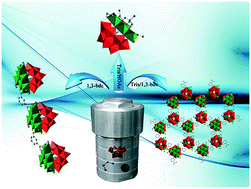Syntheses, structures and properties of three organic–inorganic hybrid polyoxotungstates constructed from {Ni6PW9} building blocks: from isolated clusters to 2-D layers†
Abstract
Three new hexa-NiII-substituted organic–inorganic hybrid polyoxotungstates, H[Ni0.5(en)(H2O)][Ni6(en)3(OAc)2(Tris)(H2O)2(B-α-PW9O34)]·5H2O (1), [Ni(en)2][Ni6(en)3(μ3-OH)3(1,3-bdc)(H2O)2(B-α-PW9O34)]·9H2O (2) and [Ni(en)(H2O)4]3[Ni6(en)3(Tris)(1,3-bdc)1.5(B-α-PW9O34)]2·8H2O (3) (en = ethylenediamine, Tris = tris(hydroxymethyl)aminomethane, 1,3-bdc = 1,3-benzenedicarboxylate) were hydrothermally synthesized and characterized. Both 1 and 3 contained {Ni6(Tris)(en)3(B-α-PW9O34)} units, whereas 2 was constructed from [Ni6(en)3(μ3-OH)3(B-α-PW9O34)] units. 1 is a new monomer. 2 comprises a 1-D chain built by [Ni6(en)3(μ3-OH)3(B-α-PW9O34)] structural building units (SBUs) linked by 1,3-bdc ligands. 3 represents the first 2-D polyoxometalate cluster-organic frameworks (PCOFs) with a honeycomb-like lattice that consists of [Ni6(en)3(Tris)(B-α-PW9O34)] SBUs linked by 1,3-bdc ligands. 1 indicated ferromagnetic coupling interactions existing in the hexa-NiII clusters. 1–3 showed excellent adsorption capabilities for MB and 3 exhibited good electrocatalytic activities for H2O2 and NaNO2 reduction.



 Please wait while we load your content...
Please wait while we load your content...